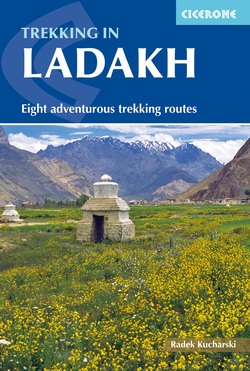Читать книгу Trekking in Ladakh - Radek Kucharski - Страница 9
На сайте Литреса книга снята с продажи.
ОглавлениеPREFACE
Ursi village, and the Tar La high above (Trek 7 Stages 5–6)
My initial foray to the Himalayas was in 2000, to India and Nepal, where the Annapurna region gave me my first taste of the fascinating Himalayan Buddhist culture. I also visited the Karakoram of Pakistan. However, it was the mountains of Ladakh that drew me back to India in 2004. I was bewitched by the place, enchanted as much by the friendly, kind, hard-working and joyful people as by the tranquil landscapes and stunning vistas. Just being in Ladakh seems to bring a special peace of mind and calmness not easily found elsewhere.
I knew I would have to return again and again to experience the fabulous trekking trails, enchanting villages and magical monasteries. Trekking in the wild gorges, climbing to a high pass dusted with pristine snow, hiking under crystal-clear skies, enjoying a freshly brewed cup of tea with a stranger – these are the special qualities of Ladakh that stay in the memory forever.
To satisfy my newfound addiction I spent four months there in 2009, exploring the landscapes on foot, and covering more than 1000 kilometres. And still Ladakh draws me back! I remember leaving the region in late October 2009, at the approach of winter. As the plane took off, we flew over Spituk Gompa and then turned towards the southeast. I looked down at the passes I had and had not yet crossed, dreaming of re-walking the first and exploring the latter.
I am lucky to have had the chance to visit Ladakh a few more times since this guidebook was first published. I’ve re-trekked major parts of some routes and tested a few new options. There are some changes in the book based on this experience. January 2014 found me trying to trek in Ladakh in winter; and now, here I am again, getting ready for another winter trek!
Ladakh is changing. Roads are expanding along old trails and trekking routes. They make some places easily accessible, but they also reduce some treks or make them less enjoyable, particularly the classic Darcha–Padum and Padum–Lamayuru treks. There has also been a large increase in the number of visitors. There are more guesthouses in Leh, more cars, and a bigger impact on the environment. It is probably more important now than ever that we leave as few traces on the trail as possible, consume minimal resources and – in general – prepare our trip with consideration for the environment.
I hope this book will help you to find your own Ladakh story. I’m quite sure that once you have had one, you will want to have more. And my wish is that you will experience as much pleasure, enjoyment and fulfilment as I have in this incredible part of the world.
Radek Kucharski
December 2014
Leh, Ladakh
